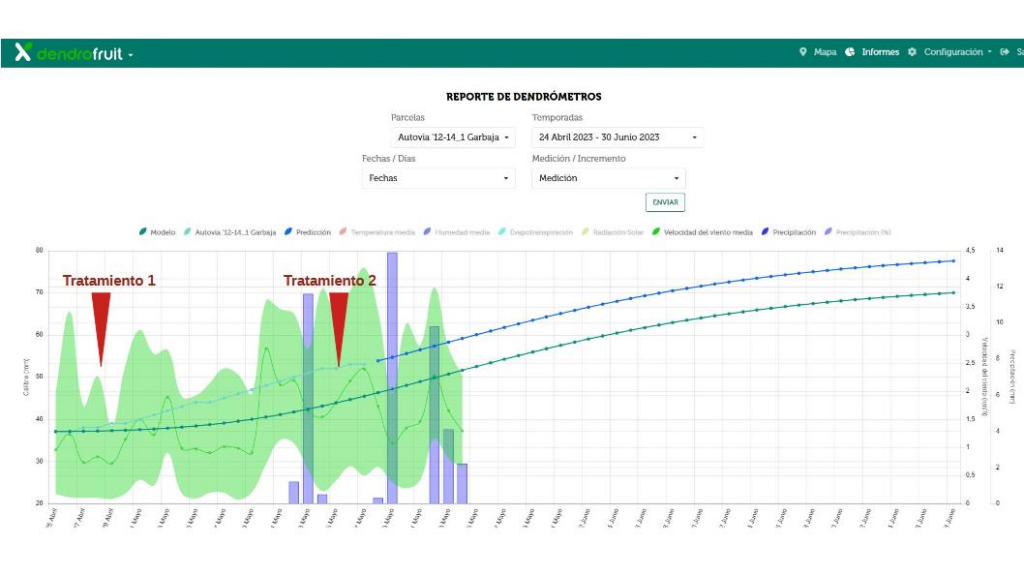In the previous article, we discussed the value of combining the fruit growth curve provided by DendroFruit with the climate data corresponding to the location of the dendrometers. DendroFruit is a diameter growth sensor patented by AGERPIX. The data it provides has undeniable value for agricultural farm management, replacing manual and sporadic measurements with a connected, real-time monitoring system that covers the entire orchard.
It allows data to be organized in a database, which in turn enables the creation of robust prediction models that can include factors such as climate conditions, fertilization, irrigation, thinning, fruit load, and pests and diseases. Including climatic variables allows simulations of different scenarios and helps anticipate harvest and production timing. These models are general enough to adapt while being adjusted to the current conditions of the crop.
When we talk about field predictions, we must understand that the context is highly variable, and climate is one of the most influential factors affecting daily decision-making. Taking this into account, the Agerpix application includes a tool that allows users to quickly check fruit growth status and climatic conditions at a glance.
Climate data is collected from specialized meteorological services capable of global data acquisition, such as AEMET or Meteoblue. Climate data from proprietary weather stations or sensors near the dendrometer’s location are particularly valuable, as they are much more accurate and the association between data is highly informative. The growth model increases in precision as variables related to vegetative development — such as radiation and temperature — are included.
In the Agerpix application, we can visualize the relationship between fruit diameter (mm) and the following climatic variables:
- Precipitation and relative humidity: During the fruit filling stage, water is essential. Conversely, during ripening, the fruit requires less water. The representation of precipitation and relative humidity helps determine development stages and their water needs. For example, it allows us to identify water shortages before harvest — which may indicate early ripening — or to anticipate fruit cracking caused by excessive rainfall. In addition, high humidity and precipitation levels create favorable conditions for disease development, making this information vital for preventive planning and treatment scheduling.
- Temperature: The graph allows us to link growth dynamics with daily average temperature and the difference between maximum and minimum temperatures recorded in a given day. It helps detect extreme events such as frost or heatwaves, even up to a week in advance. Identifying high temperatures during growth enables predictions of accelerated fruit maturation. Therefore, temperature acts as an early indicator of fruit growth trends. Confidence intervals show day–night temperature differences, which are used by farm technicians to assess proper color development. Temperature also affects fruit composition, nutrition, and texture. Moreover, it serves as a good predictor for the appearance of certain pests, allowing quick response and mitigation.
- Evapotranspiration: Especially in the current context of water scarcity, it is essential to optimize irrigation use in order to maximize yields without affecting product quality. This measurement represents the net water consumption per plant, providing an idea of the crop’s water requirements and facilitating decision-making in water resource management.
- Radiation: It has a major influence on tree development and fruit quality. Optimal solar radiation enhances fruit color by promoting greater pigment synthesis (such as anthocyanins and lycopene), increases Brix levels, and raises dry matter content, which affects the nutritional composition of the fruit. However, excessive solar radiation can cause stress, reducing plant productivity. If prolonged, it may lead to sunburn or scalding on the fruit surface. Therefore, determining whether radiation levels are appropriate helps take corrective measures and prevent losses in both yield and quality.
- Wind speed: This parameter indicates whether fruit should be monitored for surface damage caused by friction between fruits or contact with branches. Such abrasions or marks on the skin can become entry points for diseases, which need to be carefully monitored.

The data generated by DendroFruit helps relate the stage of fruit development to its needs and detect any potential problems requiring attention. By analyzing historical data, we can anticipate pest risks, plan specific actions, and stay aware of whether our production targets are on track or if intervention is needed.

In summary, the combined analysis of fruit growth and climatic variables enables early detection of issues affecting fruit quality and supports informed decision-making on resource management.


